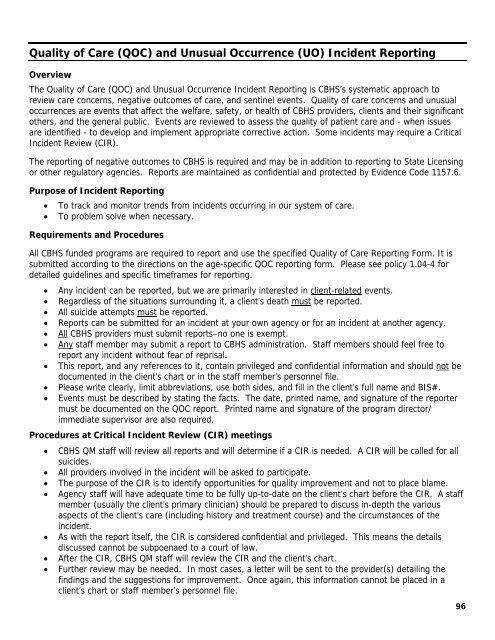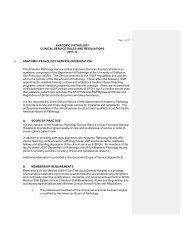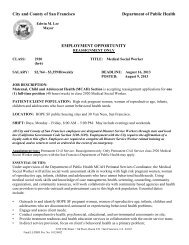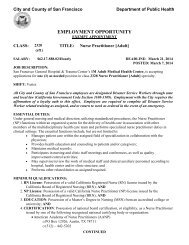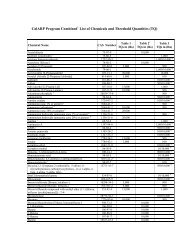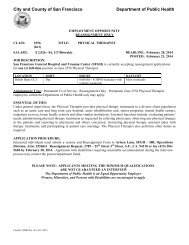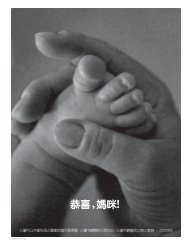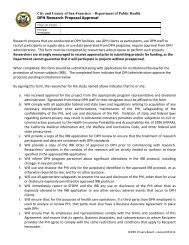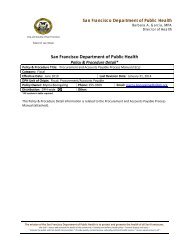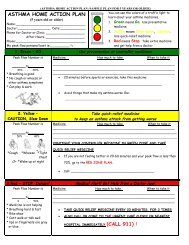Community Behavioral Health Services - San Francisco Department ...
Community Behavioral Health Services - San Francisco Department ...
Community Behavioral Health Services - San Francisco Department ...
Create successful ePaper yourself
Turn your PDF publications into a flip-book with our unique Google optimized e-Paper software.
Quality of Care (QOC) and Unusual Occurrence (UO) Incident ReportingOverviewThe Quality of Care (QOC) and Unusual Occurrence Incident Reporting is CBHS’s systematic approach toreview care concerns, negative outcomes of care, and sentinel events. Quality of care concerns and unusualoccurrences are events that affect the welfare, safety, or health of CBHS providers, clients and their significantothers, and the general public. Events are reviewed to assess the quality of patient care and - when issuesare identified - to develop and implement appropriate corrective action. Some incidents may require a CriticalIncident Review (CIR).The reporting of negative outcomes to CBHS is required and may be in addition to reporting to State Licensingor other regulatory agencies. Reports are maintained as confidential and protected by Evidence Code 1157.6.Purpose of Incident Reporting• To track and monitor trends from incidents occurring in our system of care.• To problem solve when necessary.Requirements and ProceduresAll CBHS funded programs are required to report and use the specified Quality of Care Reporting Form. It issubmitted according to the directions on the age-specific QOC reporting form. Please see policy 1.04-4 fordetailed guidelines and specific timeframes for reporting.• Any incident can be reported, but we are primarily interested in client-related events.• Regardless of the situations surrounding it, a client’s death must be reported.• All suicide attempts must be reported.• Reports can be submitted for an incident at your own agency or for an incident at another agency.• All CBHS providers must submit reports–no one is exempt.• Any staff member may submit a report to CBHS administration. Staff members should feel free toreport any incident without fear of reprisal.• This report, and any references to it, contain privileged and confidential information and should not bedocumented in the client’s chart or in the staff member’s personnel file.• Please write clearly, limit abbreviations, use both sides, and fill in the client’s full name and BIS#.• Events must be described by stating the facts. The date, printed name, and signature of the reportermust be documented on the QOC report. Printed name and signature of the program director/immediate supervisor are also required.Procedures at Critical Incident Review (CIR) meetings• CBHS QM staff will review all reports and will determine if a CIR is needed. A CIR will be called for allsuicides.• All providers involved in the incident will be asked to participate.• The purpose of the CIR is to identify opportunities for quality improvement and not to place blame.• Agency staff will have adequate time to be fully up-to-date on the client’s chart before the CIR. A staffmember (usually the client’s primary clinician) should be prepared to discuss in-depth the variousaspects of the client’s care (including history and treatment course) and the circumstances of theincident.• As with the report itself, the CIR is considered confidential and privileged. This means the detailsdiscussed cannot be subpoenaed to a court of law.• After the CIR, CBHS QM staff will review the CIR and the client’s chart.• Further review may be needed. In most cases, a letter will be sent to the provider(s) detailing thefindings and the suggestions for improvement. Once again, this information cannot be placed in aclient’s chart or staff member’s personnel file.96


